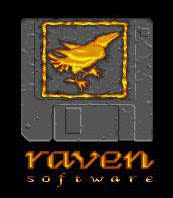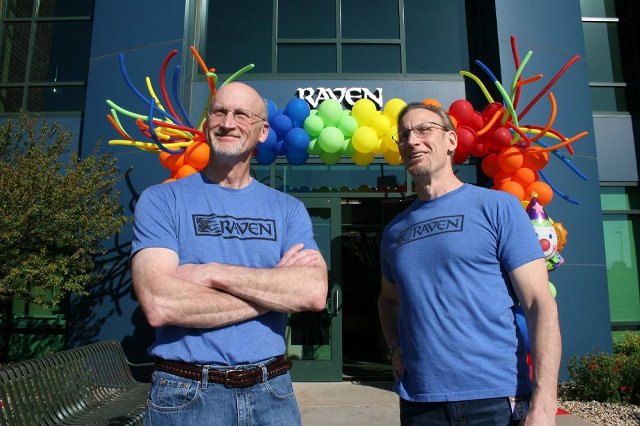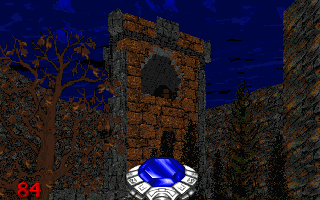❝In those days we all wore many hats.❞
Brian Raffel's interview03/13/2021
 One of the greatest names of the industry, Brian Raffel founded Raven Software 30 years ago with his brother Steve and that crazy adventure led to some of the most famous and beloved games of the era, especially the Serpent Riders trilogy. Still the head of the studio nowadays, Brian kindly accepted to save some time to answer a few questions and come back to the genesis of a legendary endeavor...
One of the greatest names of the industry, Brian Raffel founded Raven Software 30 years ago with his brother Steve and that crazy adventure led to some of the most famous and beloved games of the era, especially the Serpent Riders trilogy. Still the head of the studio nowadays, Brian kindly accepted to save some time to answer a few questions and come back to the genesis of a legendary endeavor...
Nota bene: Due to Brian's very busy schedule and Raven's PR right of inspection, the interview below is a sensibly simplified version of an initial far longer and (probably too much) in-depth list of questions about various behind-the-scene aspects. It's all the more noteworthy that despite the constraints Brian committed to sharing very nice and interesting information and even got Michael Raymond-Judy (another well-known historical member of the Raven team) to add his own participation about the Heretic/Hexen lore at the end of the interview!First would you please tell us a bit more about yourself?
Sure thing! I was born and raised in Madison, Wisconsin, and have 7 siblings - one of which is my older brother Steve who formed Raven with me in 1990. I started out as a High School Art teacher and during my summers off, I worked with Steve making a Dungeons and Dragons Module called “The Well”. My hobbies include working out, running, martial arts, spending time with my family, and raiding in World of Warcraft.
My brother Steve and I started working together in 1988 but didn’t formally start the company until 1990. As I mentioned previously, it started off as a D&D module but, as we had a passion for RPGs and fantasy worlds, we got our Amiga computers in 1986-1987 and started to teach ourselves how to create artwork on them. Remember there was no internet or gaming schools so there was only the manual and discovering your own techniques. Steve was a very good artist and taught me many of the techniques he learned. Being that we were both artists, we soon developed our skills to a point where we decided to create a videogame rather than a module. We then proceeded to work on a demo for our first game BLACK CRYPT.
The name Raven came from Tim, a friend of ours who we played D&D with around the same time we decided to start a game company. Steve was very insistent that we do not make some tech name like a computer company but more of a medieval name to reflect our game Black Crypt. Tim was quite a character in his own right but he had this Warrior named Raven who was his main character through many of our D&D adventures. We thought his name and the mystery behind the name Raven made a lot of sense.
Here was our first logo attempt at Raven:

Let's talk about Raven's firsthand partnership with id Software. How that partnership started?
We met the team from id Software software right after we finished our first game BLACK CRYPT on the AMIGA. Our publisher at the time thought it would be good to switch from the AMIGA to the PC to generate more sales. We would need to hire a programmer that knew the PC, so we placed an ad in the Madison, WI state paper looking for a PC Programmer. There were very few game developers in 1991 so we knew we had our work cut out to find one. Little did we know just a mile from our office, id Software was working on Wolfenstein and Commander Keen. John Romero saw our ad and reached out to us. They came to our office and we became friends from there and decided to work together on some future projects! id Software was a great partner for us and we would not have made it without them.
In the early days of Raven, Steve was the company president and I managed the payroll, legal, and accountant work. Owning a business was new to us and I had the connections and patience to work on that part of the business. Steve and I split the work and I had to do more the office work while Steve focused on a new game, we were working on besides Heretic. We realized early on we had to have a least two games to survive in the game business. I did work as the AD and PD but John Romero was our Executive Producer, so he was instrumental in much of the game. However in those days we all wore many hats. Steve, Brian Pelletier, and I created all the weapons, creatures, and textures with additional help later on from Shane Gurno.

Brian Raffel at Raven's first office (1990)
As I look back, I am very proud of how we honored the DOOM engine and added our own creative innovations that made our game stand on its own. A worthy brother to the mega hit DOOM in those days. I am very proud of the artwork we all did and the maps we created.
When creating Hexen II, we wanted to use the four horsemen of the apocalypse and traveling through time to some degree. We also had a small team but new Quake engine tech, so we wanted to help our development by scanning some photos of wall art from those ancient civilizations. By scanning (which was cutting edge tech at the time) we would get great images and we could do our original textures off those art styles. We also thought people would love to walk around in a world that reflects our own. I often thought it would be cool to recreate an Egyptian city and feel what it was like to live in that time.
And that was damn cool for sure!

Steve and Brian Raffel at the occasion of Raven's 25th anniversary celebration (2015)
When we first started to make Heretic, we designed it far more complicated. iD was our publisher and had just published DOOM which literally changed the gaming world forever. It was decided that it would be better to simplify the design for Heretic and follow the blueprint of DOOM but with a fantasy twist. It was the right move at the time, as people were loving doing deathmatch for the first time and we had the opportunity to keep it simple and give people a different flavor of deathmatch. We also added our own touches with flying and fun things like the morph ovum. A fan and personal favorite of mine.

I did so many, particularly DM maps that I can’t remember but the one I am most proud of is the first level in Hexen with the bell tower, breaking stained glass, and the blowing leaves. I feel like I captured a nice environment and good flow for those days. I love making maps!

Forever memorable...

BONUS! – Heretic/Hexen Story: How it was written and evolved
Written by Michael Raymond-Judy –
(designer on many of Raven's early games and creator of most of the Heretic story)
❝The concept of three “Serpent Riders” came mainly from D’Sparil.❞
As I recall the actual story wasn’t complete until near the end of the game, and I think we were already in the pre-planning stage of Hexen, so probably Korax was at least in concept form. EA wanted something to include that explained why the character was there, and so we sort of scrambled for ideas before I put it into story form.
The details of the story came mainly from the three hubs – city, lava pits, and the Dome of D’Sparil. I brainstormed with you and Steve to get parameters and hit up the other guys for their impressions of story to try to make it fit what the game actually did content-wise. The concept of three “Serpent Riders” came mainly from D’Sparil, but when we started working on Korax (and later Eidolon) mentally I was thinking “serpent” was more like “world serpent”, though I know that never got officially into the game. By then it was sort of just a thing we rolled with.
I used a lot of my fantasy obsession with works by Tolkien, Michael Moorcock, and the like to generate a mental image of the world as a whole. I wanted to start in a “small” part of the world that we could hopefully expand later. I think the background concept of the main character (intentionally nameless at that time I think) and the enemies were developed by everyone as we went, I just tried to put it into a blurb for the manual and promotional material (see below). It’s funny how dedicated people became to the actual text after the fact, though I did try to allow for that when writing for Hexen.
While tech work was in progress for Hexen, we worked on the expansion pack for Heretic (Shadow of the Serpent Riders) and that story was pretty much just “you thought you were going home but no D’Sparil tricked you!”. We were under a pretty intense dev time I think so we figured story could be limited to general descriptions.
The story for Hexen was definitely more deliberate in concept but ended up with less of a “plot” in some ways, which is weird. We first hashed out the character classes, sketched in the hub layout, and then I started on background. The whole concept was based on Korax and the Chaos Sphere, which he used to corrupt the leaders of the three main power centers – the Church, the Legion, and the Arcanum (magic users). The names I chose for these characters were more sort of “after they became corrupt” than anything – Traductus means traitor, Menelkir (the mage) means “sky cleaver” in Tolkien elvish, and Zedek (leader of the Legion) came from an old (I think middle eastern?) deity that I can’t find much on, again it probably came from a book.
The character names were mostly pulled from RPG games and books – Parias for the cleric, I sort of played off the term heretic; Daedolon was a mage in one of my D&D campaigns, and Baratus was a warrior from a book (forget which one). Honestly, I think that was the main part of the story involving them, that they had to make their way from the outer limits of the realm Cronos (original, I know) and gradually get closer to Korax’s stronghold. They end up facing the three leaders, which in some ways I later thought maybe should have come earlier, since they were not nearly as tough as the Heresiarch – but it fit the story better.

 Inky's Hexen II Mapping Corner...
Inky's Hexen II Mapping Corner...